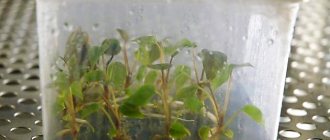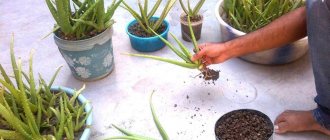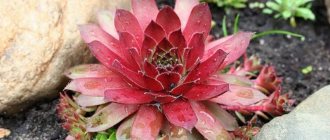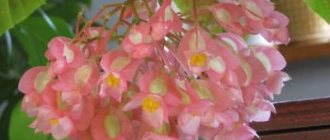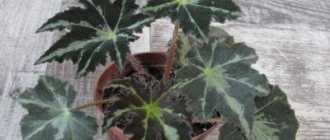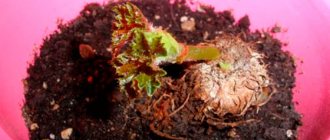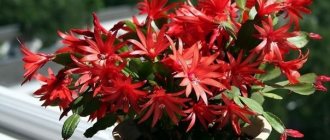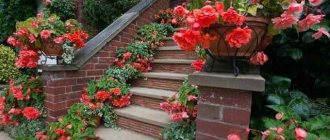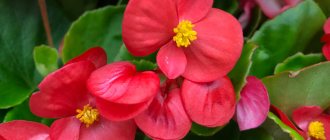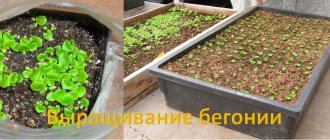The unique pattern on the leaves will prevent this variety from being confused with other begonias.
Plant growers compare it with the image of a dark-colored Maltese five-fingered cross. The beautiful appearance and moderate unpretentiousness of Mason's begonia allows it to be widely used to create an atmosphere of comfort in homes. This is a perennial herbaceous plant that pleases its owners for a long time. Our advice on care, propagation and treatment will help people who have no experience in floriculture grow Mason begonia at home.
Description
Below is a description and photo of the Mason begonia variety, suitable for propagation and care at home.
Appearance and photo
The leaves of Mason's begonia have an asymmetrical heart-shaped shape, their surface is rough and covered with small hairs. The color range of the base varies from light yellow to bright green , and the pattern can be either dark green or dark brown. Gradually they acquire silvery shades. The photo below shows Mason's begonia:
The leaf sizes reach 15 centimeters in length and 17 in width. The height of the average bush is 30 centimeters, the largest specimens reach half a meter. The root system is represented by tubers.
Flowering occurs in small, inconspicuous panicle inflorescences that do not form seeds and are useless, so it is better to remove them. The photo below shows the flowering of the Mason variety:
Lifespan
The average lifespan of a Mason begonia is 15-20 years, but proper care can increase the lifespan by 5 years.
These flowers are believed to promote business development. Their presence helps to show intuition when making important decisions and conducting trade transactions. Businessmen love to put them in their offices.
Begonia pruning
The main thing when pruning begonia is to know its variety:
- Ampelous varieties are not pruned;
- In tuberous plants, it involves removing the above-ground part before wintering;
- When pruned, bush varieties become fuller, bloom well and look younger, like ladies after a successful haircut at the hairdresser.
Anti-aging pruning technique:
- Using garden shears or pruning shears, cut off the top.
- We shape the crown by removing some side shoots and lower leaves.
- After pruning, we don’t get carried away with watering, giving the renewed begonia time to grow.
Care
What kind of pot is needed for planting?
For Mason's begonia, you should take a pot with large drainage holes of a suitable size. The soil, as for all indoor plants of this family, should be enriched and loosened.
Adults are unpretentious, but when transplanting and planting new flowers, you need to take loose soil with a large supply of oxygen . The quality of the soil and the presence of useful microelements are an important component of the beauty of your future plant.
A good combination is the use of peat and black soil in equal quantities.
Lighting, location
Mason's begonia thrives on south-facing windowsills.
The plant loves good lighting, but direct sunlight scares it. Lack of light leads to loss of brightness and color saturation, and also provokes inexpressiveness of the picture.
If climatic conditions and location provide insufficient light, artificial lighting can be created using fluorescent lamps. Do not leave Mason begonia in dark rooms , this will destroy it.
Temperature
The optimal temperature is considered to be 18-24 degrees. Mason's begonia does not tolerate low temperatures at all; coolness below 13 degrees can destroy a houseplant.
During the winter dormancy period, the temperature can be reduced to 16, but it should remain unchanged. The flower does not like sudden changes. Drafts are also contraindicated for him.
Humidity, watering
Mason's begonia loves damp areas. The plant is sensitive to this indicator, so it is worth using a humidifier, reaching medium and high levels. 70% is ideal. You can place the tray on wet expanded clay or pebbles.
Do not spray the surface of the leaves with water to increase the humidity level. This can cause rotting and cause powdery mildew.
Since the plant is a rhizomatous begonia, watering should be done only after the soil surface has dried by about 2 centimeters . The flower stores liquid reserves in the roots.
Top dressing
The plant must be fed year-round, with the exception of dormant times.
The procedure is carried out once a month, using a fertilizer concentration two times less than that indicated on the package. You cannot feed a flower in dry soil! This can cause chemical burns from fertilizers.
Winter dormant period
If Mason's begonia suddenly begins to dry out, you should not throw it away. The plant is simply going through a dormant mode, characteristic of the winter period. It lasts one and a half to two months.
At this time, you should limit watering, maintaining minimum soil moisture , cover the plant with film or a plastic cap. Reduce the temperature to 16 degrees. After some time, young leaves will appear and the active growth phase will begin, which requires increased watering.
Transfer
It is advisable to carry out a transplant once every 1-2 years after the sleep phase. This will give impetus to the development of the plant. The procedure is necessary to get rid of depleted soil, replacing it with enriched and fresh one.
You cannot replant Mason's Begonia during the flowering period!
It is worth taking a large pot of small height, but with a large diameter. This form will provide space for good development and comfort of the rhizome. You need to dig up and clean the flower from the old soil. A drainage made of expanded clay or crushed bricks is placed at the bottom of a spacious container , and the plant is lowered on top.
Fill with loose soil, actively water and remove excess water.
Rules for maintaining humidity and air temperature
You should carefully consider the microclimate requirements for keeping tropical plants, which are characterized by high air humidity and temperature control. It is not allowed to moisten begonia by spraying, since drops of water falling on the surface of the leaf cause unaesthetic spots to form and the plant loses its decorative appearance.
The optimal solution would be to plant begonias in a flower pot with high legs. The water in the pan that does not reach the drainage hole will serve to humidify the air. Vessels with water located in close proximity to begonias perfectly increase humidity. The double pallet system is used when there is not enough free space on the windowsill. The lower tray is filled with pebbles, on which the upper tray with the pot is placed. The lower container is filled with water.
In terms of air temperature, the optimal range for begonias is +20+24 °C during active growth. In winter, the temperature in the room with the plant should not drop below +15 °C. Begonia may die completely in a cooler room. Air humidity requirements remain the same throughout the year.
Reproduction
The Mason variety does not produce seeds, so propagation is carried out by vegetative methods:
Tuber division
The procedure is carried out as follows:
- a part measuring 6-7 centimeters is separated, on which there is a kidney. It is she who will become the future plant,
- the cut is sprinkled with crushed ash and sent to moist soil or a purchased peat-based substrate,
- the surface of the soil with the future plant is covered with polyethylene until rooting, sent to a bright and warm place,
- you need to look at the begonia once every 5-7 days. When young shoots appear, remove the film and, if necessary, replant the plant.
You can make your own substrate. It is necessary to take in equal shares:
- perlite,
- peat,
- sphagnum.
The purchased substrate must first be filled with water , and after 3-5 hours the excess liquid must be drained. It is better if the base is damp rather than wet.
Leaf propagation
The appearance of sprouts occurs after 14–21 days. The process consists of the following steps:
- prepare loose soil or substrate in a pot,
- a large leaf of a flower is separated with a knife, cuts are made along its veins (veins),
- The leaf is placed on the soil and pressed to the surface. You can use a hairpin,
- We cover the plant with polyethylene and place it in a bright place, but without direct sunlight. After the shoots have formed, we open the new Mason begonia.
A large, healthy leaf can sprout in plain water, but some experienced gardeners dig it and its cuttings completely into the soil.
Mason's begonia: home care, photo, reproduction
Indoor plants grow on the windowsills of many apartments. Some gardeners have many of these pets, and are happy to combine them with each other. But caring for such a variety of plants is very difficult; you can give preference to only a few self-sufficient crops that will not be very capricious. Mason's begonia, the photo of which is in front of you, is one of these. Let's clarify what care it needs at home and discuss the propagation of such a flower.
Read also: How to grow croton (codiaum): planting and care at home
Mason's begonia is a fairly recognizable plant. After all, each of its leaves is covered with an unusual pattern - a cross-shaped pattern, painted dark brown. Therefore, this indoor plant looks great on its own, and can become a bright accent in a flower arrangement.
Each leaf of such a plant can reach twenty centimeters in height, and the color of the foliage can be different - from yellow to green. In older specimens, the foliage becomes slightly silvery. The leaves themselves look quite large and have a sharp end. Their shape is heart-shaped and their surface is warty.
This is a photo of Mason's begonia
Mason plant - care must be correct
!
A Mason flower at home needs systematic and fairly abundant watering. It is carried out after the top layer of soil has dried a little. The plant reacts negatively to both drought and excess moisture. Usually the soil is watered twice a week, and even less often in the cold season. In no case should the liquid get on the leaves of the flower, as in this case the begonia may suffer from powdery mildew or rot.
An important role is played by the organization of sufficient environmental humidity.
Mason's begonia thrives in dense, indirect light. For readers of Popular Health, it is best to grow it on southwest or southeast windows, shading it from direct sunlight.
Mason's begonia feels best at a stable room temperature - from eighteen to twenty-five degrees. In the cold season, there is no particular need for a strong decrease in temperature and a cool winter. The thermometer readings should not fall below fifteen degrees, otherwise the plant may die.
Any temperature fluctuations negatively affect the health of Mason's begonia, as well as drafts.
The plant is able to remain decorative and live for fifteen to twenty years, or even more. To do this, you must periodically include feeding in your care for Mason’s begonia using special mineral products. Feeding is usually carried out once a month throughout the year. In order not to harm the root system or cause burns, you should use fertilizers only after watering.
During the cold season, at home, Mason's begonia may dry out, which indicates the beginning of hibernation. At this stage of life, the plant needs rest, so it needs to be covered with a transparent container. After two to three weeks, new shoots should appear on the bush, and the shelter must be removed.
During the dormant period, it is only necessary to periodically moisten the soil as it dries. No feeding is carried out.
After the end of the dormant period, in the spring, you can replant the plant. Mason's begonias need containers with a good drainage system. The pot should be one or two sizes larger than the previous one. During replanting, you should not compact the soil, since a sufficient amount of air must be supplied to the begonia's root system. Soil for the plant can be purchased at any flower shop.
Possible pests and diseases
Mason's begonia can suffer from whitefly; when attacked by such a pest, the leaves of the plant curl up and become covered with dark spots. The affected parts must be removed and the bush sprayed with an insecticide.
Powdery mildew is also possible, in which case fragments of a snow-white coating appear on the leaves. The affected parts should be removed and the plant should be sprayed with a fungicide.
Mason plant - propagation in different ways
Such a plant does not produce seeds; it can only be propagated by leaves and by dividing the tuber.
To propagate begonias, you need to select long tubers - at least seven centimeters. Each of them should have buds.
The cut area must be sprinkled with crushed ash. Afterwards, the tuber should be placed in moist soil. Until complete rooting, you need to cover the plant with polyethylene or a glass jar, and it should also be kept in a well-lit and warm place. Successful rooting is signaled by the appearance of young leaves. At this stage of cultivation, you can remove the shelter and plant young plants in new containers.
Thus, Mason's begonia is an excellent ornamental plant that is not capricious and grows normally on the windowsills of ordinary apartments.
Diseases and pests
Most often, diseases occur due to improper care. The main risk factors include inappropriate humidity and temperature conditions, which were discussed earlier. The most common problems are :
- Infection of leaves with mold, called gray mold. The damaged areas fall off when you move the Mason begonia or even when you turn the pot. It is advisable to replant the plant, clean the infected areas and treat with a weak solution of potassium permanganate.
- Mealybugs called hairy aphids. It appears as a fluffy coating on the surface of the leaves as a result of contamination with dust and dirt. The affected areas are removed, the surface is cleaned with soapy water, and treated according to the instructions with chemicals that can be purchased at a specialized store.
- Powdery mildew, the symptoms of which are similar to the previous disease. The difference is that the plaque is localized on the stems and leaves and is small in size. Appears due to improper hygiene and can be treated with fungicide. This is an antifungal chemical.
- Infection with whitefly - a pest similar to the white fly. The problem occurs at high humidity and temperature. To get rid of it, you need to move the plant to a drier place and treat it with medicine.
This variety of begonia was brought from the city-state of Singapore in the middle of the last century by Maurice Mason, in whose honor it received its name. He himself called it the “Iron Cross”.
Main difficulties in growing
The plant has specific problems inherent in this particular species. These include:
- Brown spots and streaks indicating a lack of moisture. Moisturizing will correct the problem in a matter of days.
- The dying and falling of individual leaves hints at the plant being overcooled or exposed to drafts. Rearrange the flower and everything will go away.
- Overwatering can cause root rot, which will result in yellow and wilted leaves. To save it, you need to replant the plant, removing all damaged areas of the roots in advance.
Diseases that can overtake a flower
Mason's begonia may encounter several typical problems, including:
- Dying of leaves.
- Spots on leaves.
- Powdery mildew.
- Root rot.
- Gray rot.
- Mealybug.
- Whitefly.
Now about the problems of the plant in detail:
More information can be found in the video.
Benefits for home and people
At home, the plant can perform the following functions:
- The flower is believed to purify the air, reducing the toxic effects of plastic and silicone. It is recommended to place it in bedrooms and living rooms.
- It has been found that in rooms where Mason's begonia stands, staphylococcus bacteria are 75% less likely to occur.
- For those who believe in negative and positive energy, you will be pleased to know that the plant has magical properties; it cleanses the house. If you often invite people you don't know, get a few of these flowers. They filter energy, keeping evil out.
Houseplant Mason's begonia: all about its appearance and proper care
Mason's begonia is one of the favorite plants of gardeners. With proper care, it will quickly grow and develop, giving positive emotions to you and your guests. It is most valuable due to its unusual leaves. Perhaps this is a distinctive feature of this begonia, although its size is not unimportant.
Read also: Spectacular rose “Jubilee Prince of Monaco”
Compared to other begonias, our guest is very small in size, which is of great value for a certain circle of gardeners.
Photo gallery
tchasnova
oksanazz2178
rumiantsevvaa
nataliysigaeva
roza_dudko_84
oksanatvorcheskaia
